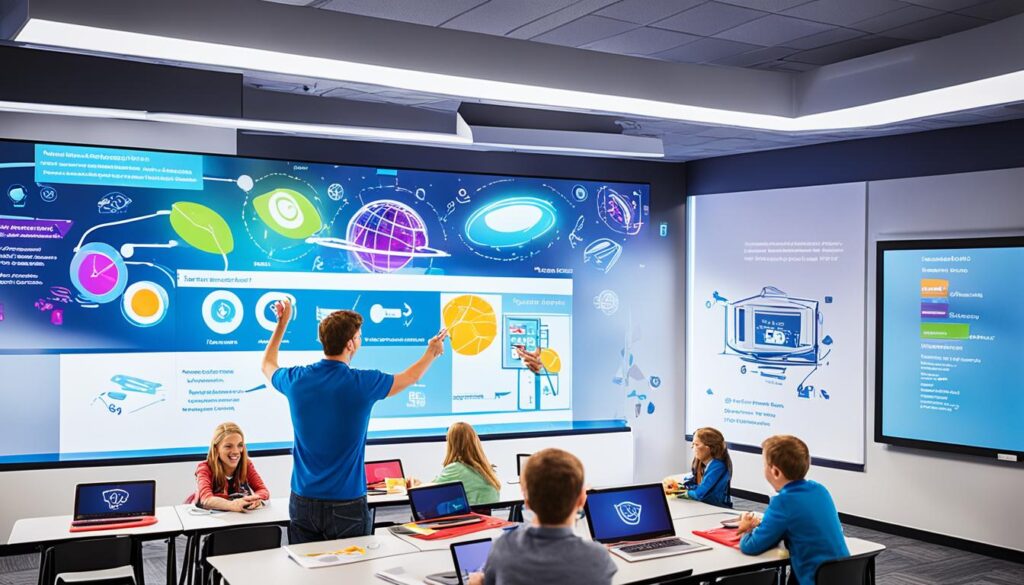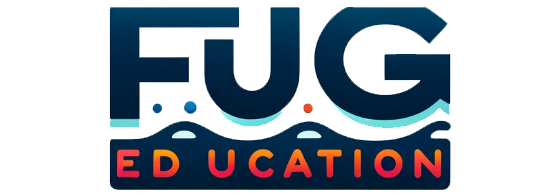Education technology, or EdTech, is rapidly transforming the landscape of teaching and learning. As we navigate through the 21st century, educators are faced with the challenge of adapting to new pedagogical approaches, especially in the wake of the COVID-19 pandemic, which accelerated the adoption of online learning. Emerging technologies have become integral tools for teachers, offering innovative ways to engage students and enhance the overall learning experience. In this article, I will explore how new and emerging technologies are empowering educators in both physical and virtual classrooms, while ensuring accessibility for all students.
Key Takeaways:
- Innovations in education technology are revolutionizing the teaching and learning process.
- Cutting-edge tech in education, such as advanced learning tools, is enhancing student engagement.
- Digital transformation in education is reshaping the educational landscape.
- Emerging technologies in education, like educational software solutions, are improving the efficiency and effectiveness of teaching.
- Technology-enhanced learning is transforming education and preparing students for the future.
Interactive Learning Platforms: Revolutionizing Classroom Engagement
Interactive learning platforms have emerged as powerful tools that are revolutionizing the way students engage in the classroom. These platforms go beyond traditional passive learning methods and introduce elements of interactivity, gamification, and virtual reality (VR) to enhance the overall educational experience.
By shifting from teacher-centered instruction to student-centered technology, interactive learning platforms create an environment where students are actively involved in the learning process. This shift allows students to take ownership of their education, fostering a sense of empowerment and motivation.
From Passive to Interactive: Student-Centered Technology
In the past, education often relied on passive learning methods, with students listening to lectures and taking notes. However, interactive learning platforms have changed this dynamic by providing tools and resources that encourage active student participation.
These platforms offer features such as interactive quizzes, multimedia content, and collaborative projects, allowing students to engage with the material in meaningful ways. By actively participating in their education, students gain a deeper understanding of the subject matter and develop critical thinking and problem-solving skills.
Through interactive learning platforms, students can access educational resources anytime, anywhere, and at their own pace. This flexibility enables personalized learning experiences that cater to individual learning styles and needs, fostering a more inclusive and effective educational environment.
Personalizing Education with Gamification and VR
Gamification and virtual reality (VR) are two key elements that are transforming education and personalizing the learning experience. Gamification incorporates game-like elements, such as challenges, rewards, and leaderboards, into educational activities, making the learning process more engaging and enjoyable.
Virtual reality (VR) takes personalization to a whole new level by providing immersive experiences that transport students to different environments and scenarios. By using VR, students can explore historical sites, conduct scientific experiments in virtual labs, or even travel to different parts of the world without leaving the classroom.
| Benefits of Interactive Learning Platforms | Enhanced student engagement | Personalized learning experiences | Improved critical thinking and problem-solving skills |
|---|---|---|---|
| Features of Interactive Learning Platforms | Interactive quizzes | Multimedia content | Collaborative projects |
| Benefits of Gamification | Increase student motivation | Make learning fun and enjoyable | Foster healthy competition among students |
| Benefits of Virtual Reality | Enhance experiential learning | Provide access to immersive educational experiences | Expand learning opportunities beyond physical constraints |
Overall, interactive learning platforms are transforming education by shifting the focus from passive learning to active student engagement. By incorporating gamification and virtual reality, these platforms enable personalized learning experiences that empower students and enhance their educational journey.
Innovations in Education Technology
Innovations in education technology are driving significant advancements in teaching and learning. From artificial intelligence (AI) to machine learning and data analytics, these emerging technologies are reshaping the educational landscape.
Educational software solutions, learning management systems, and other cutting-edge edtech tools are improving the efficiency and effectiveness of education delivery. With the integration of these technologies, educators can create engaging and interactive learning experiences that cater to the diverse needs of students.
One of the key innovations in education technology is the use of AI-powered assistants and chatbots. These assistive technologies provide immediate support to students, answering their queries and offering guidance on assignments. They also assist teachers in administrative tasks, allowing them to focus more on individual student progress and instructional design.

“Innovations in education technology have revolutionized the way we teach and learn. These advancements have the potential to improve learning outcomes and make education more accessible and inclusive.”
Data analytics and machine learning algorithms also play a significant role in education technology. These tools analyze student data to identify areas of improvement and provide personalized recommendations for each student. By leveraging these technologies, educators can ensure that every student receives tailored instruction that meets their unique learning needs.
Moreover, virtual reality (VR), augmented reality (AR), and gamification are transforming traditional learning environments into immersive and interactive experiences. These technologies engage students in hands-on learning, making the educational process more enjoyable and effective.
Overall, the ongoing advancements in education technology are revolutionizing the way we teach and learn. By embracing these cutting-edge edtech solutions, educators can create dynamic and personalized learning experiences that prepare students for the future.
| Innovations in Education Technology | Impact on Teaching and Learning |
|---|---|
| Artificial intelligence (AI) and machine learning | – Personalized learning experiences – Improved instructional design – Enhanced student engagement |
| Data analytics and machine learning algorithms | – Data-driven decision making – Personalized recommendations – Identification of areas of improvement |
| Virtual reality (VR) and augmented reality (AR) | – Immersive and interactive learning – Hands-on experiences – Enhanced understanding of complex concepts |
| Gamification | – Increased motivation and engagement – Competitive learning – Reward-based systems |
Adaptive Learning Systems: Catering to the Individual Learner
Adaptive learning systems have revolutionized education by leveraging AI-driven algorithms to provide personalized learning experiences. These systems analyze students’ learning patterns, adapt the curriculum accordingly, and ensure that each learner receives targeted support. By harnessing the power of technology, educators can address the diverse educational needs of students with varying abilities and learning styles.
AI-Driven Personalization of Learning Experiences
AI-driven personalization is at the core of adaptive learning systems. By collecting data on students’ progress, preferences, and interests, these systems create customized learning paths that cater to individual learners. The algorithms behind adaptive learning analyze data in real-time, allowing educators to gain insights into students’ strengths and weaknesses. This enables them to deliver tailored content and interventions, promoting better engagement and improved learning outcomes.
Moreover, adaptive learning systems adapt to the pace at which students learn, ensuring that they receive the appropriate level of challenge. The algorithms can identify when students are struggling and automatically provide additional resources or support. Conversely, if students are mastering concepts quickly, the system can accelerate their progress and offer more advanced materials. This adaptive approach ensures that every learner is appropriately challenged and supported throughout their educational journey.
Supporting Diverse Educational Needs with Technology
One of the major benefits of adaptive learning systems is their ability to address the diverse educational needs of students. Traditional one-size-fits-all approaches may not effectively support learners with different abilities, learning disabilities, or language barriers. However, with adaptive learning, technology can be leveraged to bridge these gaps and ensure equitable access to education.
Adaptive learning systems can provide differentiated instruction that adapts to each student’s unique needs. For example, for students with learning disabilities, the system can provide additional visual aids or auditory cues to support comprehension. Students with language barriers can benefit from real-time translation tools or language learning modules integrated into the adaptive learning system.
Furthermore, adaptive learning systems promote inclusivity by allowing students to learn at their own pace and in their preferred learning style. Some students may excel in visual learning while others may prefer auditory or hands-on approaches. By offering a variety of instructional materials, adaptive learning systems cater to different learning styles and preferences, ensuring that all students have the opportunity to thrive.
| Benefit | Description |
|---|---|
| Personalized Learning | Adaptive learning systems analyze students’ learning patterns and provide customized learning paths. |
| Targeted Support | These systems adapt the curriculum to provide additional resources and interventions for struggling students. |
| Flexible Pace | Adaptive learning systems accommodate the individual learning pace of each student. |
| Differentiated Instruction | Adaptive learning systems provide tailored instruction based on students’ diverse educational needs. |
| Inclusivity | By catering to various learning styles and preferences, adaptive learning systems ensure equal opportunities for all students. |
Collaborative Online Tools: Enhancing Communication and Teamwork
Collaborative online tools have revolutionized the way students communicate and collaborate in both physical and virtual classrooms. These tools have become essential in fostering effective teamwork and communication among students, promoting a dynamic and engaging learning environment. Virtual collaboration platforms, such as Google Workspace for Education and Microsoft Teams, have enabled real-time collaboration, breaking down geographical boundaries and creating a global classroom environment.
Breaking Boundaries with Virtual Collaboration Platforms
Virtual collaboration platforms play a crucial role in facilitating communication and collaboration among students. These platforms provide a centralized space where students can interact, share ideas, and work together on projects, regardless of their physical location. With features like real-time messaging, document sharing, and video conferencing, virtual collaboration platforms enable seamless and efficient collaboration, enhancing the learning experience for students.

Fostering a Global Classroom Environment
Collaborative online tools have the power to foster a global classroom environment, connecting students from different parts of the world. Students can collaborate with their peers, exchange cultural perspectives, and develop a global awareness through online communication tools. This global collaboration cultivates a sense of inclusivity and broadens students’ horizons, preparing them for success in an increasingly interconnected and diverse world.
By leveraging collaborative online tools, educators can create an environment where students can learn from and with each other, developing essential skills such as communication, teamwork, and cross-cultural understanding. These tools not only enhance communication and teamwork but also empower students to take ownership of their education, encouraging active participation and collaboration.
AI-Powered Educational Assistants: Transforming Support Outside the Classroom
AI-powered educational assistants, such as chatbots and virtual tutors, have revolutionized student support outside the classroom. These innovative technologies provide immediate assistance to students, offering guidance on assignments, answering queries, and providing additional learning resources. With their advanced algorithms and natural language processing capabilities, AI-powered educational assistants can simulate human-like conversations, making the learning experience more personalized and engaging.
By utilizing chatbots and virtual tutors, students can access help and support at any time, without the need for direct teacher intervention. This accessibility fosters independent learning and empowers students to take control of their education. Additionally, AI-powered educational assistants assist teachers by automating tasks like grading, allowing them to focus more on individual student progress and instructional design.
Chatbots and virtual tutors use sophisticated algorithms to analyze students’ responses, track their progress, and provide tailored recommendations. Through personalized feedback and adaptive learning techniques, these AI-powered assistants adapt their responses to suit each student’s needs, learning pace, and preferences. They can identify knowledge gaps, suggest relevant study materials, and offer interactive learning experiences to strengthen understanding.
The benefits of AI-powered educational assistants extend beyond the classroom. They enhance student engagement, provide continuous support, and enable personalized learning paths. These assistants have the potential to transform the way students learn and educators teach, ensuring that every student receives the guidance they need to succeed.
Accessibility and Inclusion Through Universal Design in EdTech
When it comes to educational technology, accessibility and inclusion are essential considerations. Universal design in edtech ensures that all students, regardless of their abilities or disabilities, have equal access to learning opportunities. By incorporating features such as closed captions, screen readers, and adjustable font sizes, educational technology can be designed with everyone in mind.
Building EdTech with Everyone in Mind
Universal design for learning is a framework that guides the development of educational materials, products, and systems to be accessible and effective for all learners. It encourages the use of multiple means of representation, engagement, and expression to accommodate diverse learning styles and preferences.
“Universal design in education means designing learning experiences that work for everyone and acknowledging that people have different strengths and weaknesses. It’s about creating an inclusive learning environment where every student can thrive.” – Jane Smith, Education Technology Expert.
By implementing universal design principles, edtech tools can cater to a wide range of students’ needs. For example, closed captions in videos not only benefit students who are deaf or hard of hearing but also support English language learners and individuals who prefer visual learning. Screen readers, on the other hand, enable students with visual impairments to access digital content.

Adaptive Technologies: Facilitating Learning for All
Adaptive technologies play a crucial role in enabling inclusive education. These technologies adjust and personalize the learning experience to meet the unique needs of individual students. Speech-to-text and text-to-speech tools, for instance, assist students with reading difficulties or language processing challenges. These tools not only remove barriers to learning but also empower students to actively participate in classroom activities.
By implementing adaptive technologies, educators can create an inclusive environment that promotes equal opportunities for all students. These technologies provide additional support and accommodations, ensuring that every learner can engage with educational content and achieve their full potential.
| Adaptive Technologies | Benefits |
|---|---|
| Speech-to-Text | Enables students with writing difficulties or motor impairments to convert spoken words into written text. |
| Text-to-Speech | Assists students with reading difficulties or visual impairments by converting text into spoken words. |
| Screen Magnifiers | Allows students with visual impairments to enlarge text and images on digital screens for better visibility. |
| Alternative Keyboards | Provides customized keyboard options for students with motor disabilities or difficulty using standard keyboards. |
| Graphic Organizers | Supports students with organizing their thoughts and ideas visually, aiding comprehension and writing skills. |
By embracing accessibility and universal design in edtech, educators can create an inclusive learning environment where every student can thrive. Adaptive technologies further enhance this inclusivity by providing personalized support tailored to individual needs. As technology continues to evolve, it is crucial to prioritize accessibility and ensure that the benefits of education reach all students, fostering a more equitable and inclusive society.
Blockchain for Educational Credentials: Securing Academic Achievements
Blockchain technology has emerged as a game-changing solution for securing and verifying educational credentials. With the increasing digital transformation in the education sector, the need for a secure and transparent system to validate academic achievements has become more critical than ever.
Blockchain provides a decentralized and immutable ledger where educational qualifications and achievements can be recorded and stored securely. This technology eliminates the risk of fraud and tampering, ensuring the authenticity and integrity of academic credentials.
By leveraging blockchain for educational credentials, students can have a digital record of their achievements that is easily accessible and verifiable by potential employers, academic institutions, and other stakeholders. This eliminates the need for time-consuming manual verification processes and reduces the risk of false claims.

The use of blockchain also empowers individuals to take ownership of their digital credentials, allowing them to maintain control over their educational achievements throughout their lifetime. This puts the power back in the hands of students, enabling them to showcase their qualifications and skills with confidence.
Furthermore, blockchain technology enables the verification of educational qualifications in real time, accelerating the hiring process for employers. With instant access to verified credentials, employers can make informed decisions and streamline their recruitment processes.
In addition to its security and verification capabilities, blockchain also opens up new possibilities for the issuance and recognition of micro-credentials and digital badges. These smaller units of learning, often representing specific skills or competencies, can be easily recorded and shared on the blockchain, providing individuals with a more comprehensive and granular representation of their educational achievements.
In conclusion, blockchain technology offers a secure and efficient solution for securing academic achievements and verifying educational credentials. By embracing this innovative technology, we can create a more reliable and transparent system that enhances trust and confidence in the education ecosystem.
Cybersecurity Measures for Data Protection in Digital Learning
Data protection is crucial in digital learning environments, and educators must implement robust cybersecurity measures to ensure the safety of sensitive student data. With the increased reliance on online education platforms and the collection of personal information, it is essential to prioritize online education security. By adopting effective cybersecurity technologies and implementing best practices, educational institutions can create a safe and secure learning environment for both students and educators.
Essential Cybersecurity Technologies for Online Education
When it comes to online education security, several cybersecurity technologies play a vital role in safeguarding data and protecting against potential threats. These technologies include:
- Encryption: Ensuring that data transmitted over networks or stored on devices is securely encrypted helps prevent unauthorized access.
- Secure Authentication: Implementing strong authentication methods, such as multi-factor authentication, adds an extra layer of security to verify user identities.
- Regular Security Audits: Conducting regular security audits helps identify vulnerabilities and address them promptly, minimizing the risk of data breaches.
By employing these cybersecurity technologies, educational institutions can significantly enhance the protection of student data and reduce the risk of cyberattacks.
Professional Development and Best Practices in Data Security
Ensuring a safe online learning environment requires more than just implementing cybersecurity technologies. Educators and staff need to receive proper professional development to understand data security risks and best practices. This includes:
- Training on Data Privacy: Educators should receive training on data privacy regulations and guidelines to ensure compliance and the responsible handling of student data.
- Creating Strong Passwords: Encouraging the use of strong passwords and regularly updating them helps protect user accounts from unauthorized access.
- Regular Data Backups: Regularly backing up data ensures that in the event of a cyber incident or data loss, essential information can be easily recovered.
- Implementing Security Policies: Establishing clear security policies and procedures helps create a culture of data protection and ensures everyone understands their roles and responsibilities in maintaining online education security.
By prioritizing professional development in cybersecurity and adhering to best practices, educational institutions can mitigate risks and proactively protect student data in digital learning environments.
Conclusion
The integration of technology in education is transforming teaching and learning, empowering educators and preparing students for the future. Emerging technologies such as interactive learning platforms, adaptive systems, and AI-powered assistants have revolutionized the traditional classroom, enhancing student engagement, personalization, and inclusivity. These innovations provide educators with powerful tools to create dynamic and interactive learning experiences.
By incorporating emerging technologies, educators can create student-centered classrooms that foster active participation and collaboration. Interactive learning platforms leverage gamification and virtual reality to make education more engaging and enjoyable. Adaptive systems powered by artificial intelligence cater to individual learning needs, ensuring personalized learning experiences for all students. AI-powered educational assistants assist students outside the classroom, providing immediate support and guidance.
The impact of emerging technologies on education is undeniable. They enable educators to break down traditional barriers and create a global classroom environment. Collaborative online tools facilitate communication and teamwork among students across geographical boundaries. Universal design in edtech ensures accessibility and inclusion for students with diverse needs, while blockchain technology secures academic achievements by providing a tamper-proof record of educational credentials.
As we move forward, it is crucial for educators to embrace technology and stay updated with the latest innovations. Integrating technology in teaching not only enhances student learning outcomes but also prepares them to navigate a digitally-driven world. By harnessing the power of emerging technologies, we can empower educators and create a future-focused education system that equips students with the skills they need to succeed.
FAQ
How are interactive learning platforms revolutionizing classroom engagement?
Interactive learning platforms transform traditional passive learning into a dynamic and interactive experience. They use elements of gamification, augmented reality (AR), and virtual reality (VR) to create immersive educational experiences. By shifting the focus from teacher-centered instruction to student-centered technology, these platforms enhance student engagement and participation.
How do interactive learning platforms personalize education?
Interactive learning platforms integrate gamification and VR technology to personalize education. These platforms cater to individual learning styles, making the learning process more enjoyable and effective. By gamifying the learning experience and incorporating VR simulations, students can engage with the content in a way that is meaningful and relevant to their own interests and abilities.
What are the latest innovations in education technology?
The latest innovations in education technology include artificial intelligence (AI), machine learning, and data analytics. Educational software solutions, learning management systems, and other cutting-edge edtech tools are improving the efficiency and effectiveness of education delivery. These innovations are reshaping teaching and learning by leveraging technology to enhance the educational experience.
How do adaptive learning systems cater to the individual learner?
Adaptive learning systems use AI-driven algorithms to analyze students’ learning patterns and adapt the curriculum accordingly. By personalizing the learning experience, these systems address the diverse educational needs of students with varying abilities and learning styles. Adaptive learning systems ensure that each student receives personalized instruction, allowing them to learn at their own pace and in a way that suits their individual needs.
How do collaborative online tools enhance communication and teamwork in education?
Collaborative online tools, such as Google Workspace for Education and Microsoft Teams, enable real-time collaboration among students. These tools foster teamwork and communication, breaking down geographical boundaries and creating a global classroom environment. Students can connect and collaborate with peers from around the world, enhancing their communication and teamwork skills while gaining exposure to diverse perspectives.
How do AI-powered educational assistants transform student support outside the classroom?
AI-powered educational assistants, such as chatbots and virtual tutors, provide immediate support to students. They can answer queries, provide additional learning resources, and offer guidance on assignments. These assistants also assist teachers in tasks like grading, allowing them to focus more on individual student progress and instructional design. AI-powered educational assistants enhance student support and ease the workload of teachers.
How does universal design in edtech ensure accessibility and inclusion for all students?
Universal design in edtech ensures that educational technology is designed with everyone in mind. It incorporates features such as closed captions, screen readers, and adjustable font sizes to make education accessible to students with disabilities. Adaptive technologies, like speech-to-text and text-to-speech tools, facilitate learning for students with diverse needs. Universal design in edtech promotes inclusivity and ensures that all students can participate in the educational experience.
How does blockchain technology secure educational credentials?
Blockchain technology offers a secure and transparent solution for verifying and securing educational credentials. With blockchain, students have a digital record of their academic achievements that is easily verifiable by employers and institutions. This technology reduces the risk of fraud and ensures the authenticity of academic qualifications, providing a trusted and tamper-proof system for verifying educational credentials.
What cybersecurity measures are essential for data protection in digital learning?
Essential cybersecurity measures for data protection in digital learning include encryption, secure authentication, and regular security audits. Educators must implement these measures to ensure the safety of sensitive student data in online learning environments. Additionally, professional development and adherence to best practices in data security are crucial for educators to create a safe online learning environment for their students.
Why is it important to integrate emerging technologies in education?
Integrating emerging technologies in education empowers educators and has the potential to revolutionize teaching and learning. From interactive learning platforms to adaptive systems and AI-powered assistants, these innovations enhance engagement, personalization, and inclusivity in education. Embracing technology in education prepares students for the future by equipping them with the skills and knowledge they need to thrive in a digitally-driven world.
Source Links
- https://elearningindustry.com/empowering-educators-in-the-new-age-of-ai
- https://www.linkedin.com/pulse/revolutionizing-education-impact-emerging-effective-av3hc
- https://iste.org/blog/empowering-teachers-to-implement-technology-driven-educational-programs

